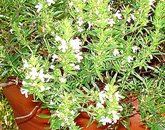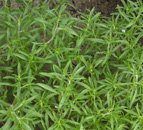Summer Savory herb Nutrition facts
Delicate, pleasantly aromatic Summer savory is one of the traditional culinary herbs featured in the East-European and American cuisines.
Botanically, this annual herb belongs to the mint family (Lamiaceae) and has the scientific name: Satureja hortensis.
The herb is well tolerant to different climatic conditions and requires good sunlight to flourish. It reaches about 40-60 cm in height. Its sister variety, winter-savory, known as Satureja montana, has a sharp, pungent flavor and hence, is less preferred in cooking.

|

|
| Summer savory with bloom. (Photo courtesy: cbertel) | Fresh herb-close up view. |
The plant bears dark green, smooth leaves and small purple flowers. Winter savory has similar growth characteristics; however, it features extensive branching and hard and woody stems.
Several wild cultivars exist apart from the garden savory. Satureja douglasii or yerba buena is one of the herbs that has been in use by the native Americans of California and Alaskan regions as herbal tea.
Satureja thymbra, is another wild herb that grows in the Mediterranean and Middle Eastern countries and is known for its high essential oil, carvacrol, and thymol chemical compounds.
Health benefits of Summer Savory herb
Savory leaves and tender shoots carry incredibly high-quality chemical compounds that are known to have antioxidant, disease-preventing, and health-promoting properties. Besides, dietary fiber in this herb helps reduce LDL or bad cholesterol while increasing HDL or good cholesterol levels.
Savory leaves contain many essential volatile oil phenols such as thymol and carvacrol, as well as compounds like linalool, camphene, caryophyllene, terpineol, myrcene, and other terpenoids.
Thymol, one of the important essential oils, has scientifically been found to have antiseptic, anti-fungal characteristics.
Also, another phenolic compound, carvacrol in the herb inhibits the growth of many strains of bacteria including E. coli, and Bacillus cereus. Carvacrol, therefore, has been used as a healthy food additive and preservative for its anti-bacterial properties. It also gives a pleasant tangy taste and marjoram like flavor to the food.
Savory herb is an excellent source of minerals and vitamins that are essential for optimum health. Its leaves and tender shoots are one of the richest sources of potassium, iron, calcium, magnesium, manganese, zinc, and selenium. Potassium is an important component of cells and body fluids that helps regulate heart rate and blood pressure. The human body utilizes manganese as a cofactor for the antioxidant enzyme, superoxide dismutase. Iron is required for red blood cell formation.
The herb is also a rich source of many important vitamins such as B-complex group vitamins, vitamin A, vitamin C, niacin, thiamin, and pyridoxine.
Dry savory provides 1.810 mg of vitamin B-6 or pyridoxine; furnishing about 130% of RDA. Pyridoxine keeps up GABA (soothing neurotransmitter) levels in the brain, which has a stress-buster function.
Vitamin-C helps the body develop resistance against infectious agents and scavenge harmful, pro-inflammatory free radicals.
Vitamin-A is a fat-soluble vitamin and antioxidant that is required to maintain healthy mucosa and skin and is also essential for good eyesight. Consumption of natural fruits rich in flavonoids like vitamin A, and carotenes helps protect from lung and oral cavity cancers.
Dry savory herb has amazingly high levels of vitamins and minerals. Just 100 g of ground dry herb provides (% of Recommended daily allowance):-
120% of dietary fiber,
25% of niacin,
130% of vitamin B-6 (pyridoxine),
83% of vitamin C,
177% of vitamin A,
474% of iron,
210% of calcium,
94% of magnesium, and
265% of manganese
but no cholesterol.
| Principle | Nutrient Value | Percent of RDA |
|---|---|---|
| Energy | 272 Kcal | 13.5% |
| Carbohydrates | 68.73 g | 53% |
| Protein | 6.73 g | 12% |
| Total Fat | 5.91 g | 30% |
| Cholesterol | 0 mg | 0% |
| Dietary Fiber | 45.7 g | 120% |
| Vitamins | ||
| Niacin | 4.080 mg | 25.5% |
| Pyridoxine | 1.810 mg | 139% |
| Riboflavin | 0.471 mg | 36% |
| Thiamin | 0.366 mg | 30.5% |
| Vitamin-A | 5310 IU | 177% |
| Vitamin C | 50 mg | 83% |
| Electrolytes | ||
| Sodium | 24 mg | 1.5% |
| Potassium | 1051 mg | 22% |
| Minerals | ||
| Calcium | 2132 mg | 210% |
| Copper | 0.847 mg | 94% |
| Iron | 37.88 mg | 474% |
| Magnesium | 377 mg | 94% |
| Manganese | 6.100 mg | 265% |
| Phosphorus | 140 mg | 20% |
| Selenium | 4.6 µg | 8% |
| Zinc | 4.30 mg | 39% |
Selection and storage
Both fresh and dried forms of the savory herb can be available in the market. Fresh leaves and stems are used for cooking during the season. However, to prepare a dry savory, the top six to eight inches of the herb sections should be gathered just before or during the bloom. Usually, cut shoots and leaves spread out on screens or paper sheets and allowed to dry at room temperature.
Dried leaves should then be stripped off the stems, stored in a tightly sealed glass container, and kept in a cool, dark, dry place where they will keep well for many months.
Medicinal uses
The summer savory herb contains many valuable essential oils, which are found to have antibacterial, and anti-fungal applications.
As in thyme, distilled tepid savory water is used for throat gargling to help relieve a sore throat and bronchitis symptoms.
The constituents in this herb part, especially the flowering shoots, have been antiseptic, carminative (anti-flatulence), digestive (helps digestion), expectorant (helps clear throat), stomachic and anti-rheumatic (relieves joint pain) functions. (Medical disclaimer).
Culinary uses
Savory leaves, fresh or dry, can be employed in cooking. Its parts have a slightly peppery and tangy taste with marjoram-like flavor. This herb has excellent blending qualities with fellow herbs.
In order to keep the fragrance and flavor intact, the savory herb is generally added at the final moments of cooking since prolonged cooking might result in the evaporation of its essential oils.
Fresh summer savory leaves are being used as a garnish in salads.
Savory herbal tea is a popular health drink.
The herb has also been used in the preparation of season soups, and sauces.
Also, along with other spicy items, the herb is used to marinate chicken, fish, and meat recipes.
≺≺ Back to Herbs from Summer savory. Visit here for an impressive list of all varietIES of herbs with complete illustrations of their nutrition facts and health benefits.
≺≺ Back to Home page.
Further Resources:
Stanford School of Medicine Cancer information Page- Nutrition to Reduce Cancer Risk.